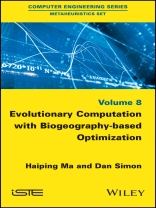Evolutionary computation algorithms are employed to minimize functions with large number of variables. Biogeography-based optimization (BBO) is an optimization algorithm that is based on the science of biogeography, which researches the migration patterns of species. These migration paradigms provide the main logic behind BBO. Due to the cross-disciplinary nature of the optimization problems, there is a need to develop multiple approaches to tackle them and to study the theoretical reasoning behind their performance. This book explains the mathematical model of BBO algorithm and its variants created to cope with continuous domain problems (with and without constraints) and combinatorial problems.
Tabella dei contenuti
Chapter 1 The Science of Biogeography 1
1.1 Introduction 1
1.2 Island biogeography 3
1.3 Influence factors for biogeography 6
Chapter 2 Biogeography and Biological Optimization 11
2.1 A mathematical model of biogeography 11
2.2 Biogeography as an optimization process 16
2.3 Biological optimization 19
2.3.1 Genetic algorithms 19
2.3.2 Evolution strategies 20
2.3.3 Particle swarm optimization 21
2.3.4 Artificial bee colony algorithm 22
2.4 Conclusion 23
Chapter 3 A Basic BBO Algorithm 25
3.1 BBO definitions and algorithm 25
3.1.1 Migration 26
3.1.2 Mutation 27
3.1.3 BBO implementation 27
3.2 Differences between BBO and other optimization algorithms 35
3.2.1 BBO and genetic algorithms 35
3.2.2 BBO and other algorithms 36
3.3 Simulations 37
3.4 Conclusion 44
Chapter 4 BBO Extensions 45
4.1 Migration curves 45
4.2 Blended migration 49
4.3 Other approaches to BBO 51
4.4 Applications 56
4.5 Conclusion 59
Chapter 5 BBO as a Markov Process 61
5.1 Markov definitions and notations 61
5.2 Markov model of BBO 72
5.3 BBO convergence 79
5.4 Markov models of BBO extensions 90
5.5 Conclusions 99
Chapter 6 Dynamic System Models of BBO 103
6.1 Basic notation 103
6.2 Dynamic system models of BBO 105
6.3 Applications to benchmark problems 119
6.4 Conclusions 122
Chapter 7 Statistical Mechanics Approximations of BBO 123
7.1 Preliminary foundation 123
7.2 Statistical mechanics model of BBO 128
7.2.1 Migration 128
7.2.2 Mutation 134
7.3 Further discussion 141
7.3.1 Finite population effects 141
7.3.2 Separable fitness functions 142
7.4 Conclusions 143
Chapter 8 BBO for Combinatorial Optimization 145
8.1 Traveling salesman problem 147
8.2 BBO for the TSP 148
8.2.1 Population initialization 148
8.2.2 Migration in the TSP 150
8.2.3 Mutation in the TSP 157
8.2.4 Implementation framework 159
8.3 Graph coloring 163
8.4 Knapsack problem 165
8.5 Conclusion 167
Chapter 9 Constrained BBO 169
9.1 Constrained optimization 170
9.2 Constraint-handling methods 172
9.2.1 Static penalty methods 172
9.2.2 Superiority of feasible points 173
9.2.3 The eclectic evolutionary algorithm 174
9.2.4 Dynamic penalty methods 174
9.2.5 Adaptive penalty methods 176
9.2.6 The niched-penalty approach 177
9.2.7 Stochastic ranking 178
9.2.8 ε-level comparisons 178
9.3 BBO for constrained optimization 179
9.4 Conclusion 185
Chapter 10 BBO in Noisy Environments 187
10.1 Noisy fitness functions 188
10.2 Influence of noise on BBO 190
10.3 BBO with re-sampling 193
10.4 The Kalman BBO 196
10.5 Experimental results 199
10.6 Conclusion 201
Chapter 11 Multi-objective BBO 203
11.1 Multi-objective optimization problems 204
11.2 Multi-objective BBO 211
11.2.1 Vector evaluated BBO 211
11.2.2 Non-dominated sorting BBO 213
11.2.3 Niched Pareto BBO 216
11.2.4 Strength Pareto BBO 218
11.3 Real-world applications 223
11.3.1 Warehouse scheduling model 223
11.3.2 Optimization of warehouse scheduling 229
11.4 Conclusion 231
Chapter 12 Hybrid BBO Algorithms 233
12.1 Opposition-based BBO 234
12.1.1 Opposition definitions and concepts 234
12.1.2 Oppositional BBO 236
12.1.3 Experimental results 238
12.2 BBO with local search 240
12.2.1 Local search methods 240
12.2.2 Simulation results 245
12.3 BBO with other EAs 247
12.3.1 Iteration-level hybridization 247
12.3.2 Algorithm-level hybridization 250
12.3.3 Experimental results 254
12.4 Conclusion 256
Appendices 259
Appendix A Unconstrained Benchmark Functions 261
Appendix B Constrained Benchmark Functions 265
Appendix C Multi-objective Benchmark Functions 289
Bibliography 309
Index 325
Circa l’autore
Haiping Ma, Shangai University, China.
Dan Simon, Professor, Cleveland State University, USA.












